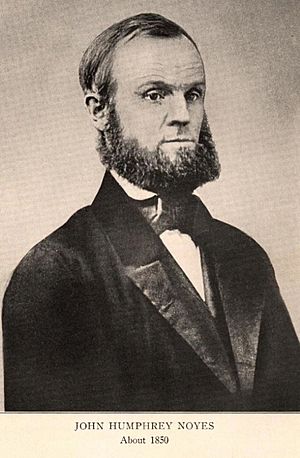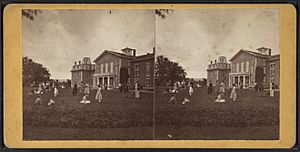John Humphrey Noyes facts for kids
Quick facts for kids
John Humphrey Noyes
|
|
|---|---|
 |
|
| Born | September 3, 1811 |
| Died | April 13, 1886 (aged 74) Niagara Falls, Ontario
|
| Education | Dartmouth College |
| Occupation | Utopian socialist |
| Known for | Oneida Community |
| Spouse(s) | Harriet Holton (m. 1838) |
| Children | Theodore Richards Noyes Victor Cragin Noyes Constance Bradley Noyes John Humphrey Noyes II Pierrepont Noyes Holton Van Velzer Noyes Gertrude Hayes Noyes Irene Campbell Newhouse Noyes Godfrey Barron Noyes |
| Signature | |
John Humphrey Noyes (September 3, 1811 – April 13, 1886) was an American preacher and thinker. He believed in creating a perfect society. He founded several special communities, including the Oneida Community. He also created the idea of "complex marriage," a unique way of living together.
Contents
Biography
Early Life and Education
John Humphrey Noyes was born on September 3, 1811. His hometown was Brattleboro, Vermont. His father, John Noyes, was a minister, teacher, and even a member of the U.S. House of Representatives (part of the U.S. government). His mother, Polly Noyes, was the aunt of Rutherford B. Hayes, who later became the 19th President of the United States.
In 1831, when John was 20, he was inspired by a preacher named Charles Grandison Finney. This led John to have a strong religious experience. He decided he wanted to dedicate his life to making the world a better place.
After graduating from Dartmouth College, he changed his plans from studying law. Instead, he went to Andover Theological Seminary to become a Christian minister.
In 1832, Noyes moved to Yale Theological Seminary. He wanted to spend more time studying the Bible. While there, he also started to get involved in politics. He helped start one of the first Anti-Slavery Societies in New Haven, Connecticut. This group worked to end slavery in the United States.
New Religious Ideas
During his time at Yale, Noyes developed some new religious ideas. He became convinced that a major event mentioned in the Bible, the second coming of Christ, had already happened in 70 AD. He believed this meant people were now living in a "new age."
Noyes also became very focused on being free from sin. He believed that true Christians could be perfect and live without sin. He felt that if people were not truly free from sin, then Christianity was not real.
After a strong personal religious experience, Noyes began to say that he "did not sin." He believed that because he had given his will to God, everything he chose to do was perfect.
In 1838, Noyes married Harriet Holton. They had five children in their first six years of marriage. Sadly, four of these children were born too early and did not survive. Only one of their children lived.
Belief in Perfection
Charles Grandison Finney, the preacher who first inspired Noyes, also believed in "Christian perfection." This idea suggests that it's possible to live without sin in this life. Noyes strongly embraced this belief.
His ideas about perfection caused some people to think he was unbalanced. His professors even called him a heretic. Noyes believed that his connection to God meant he didn't have to follow traditional rules.
On February 20, 1834, Noyes declared that he was perfect and free from sin. This statement caused a big stir at his college. As a result, his license to preach was taken away.
After being expelled from Yale and losing his license, Noyes went back to Putney, Vermont. He continued to preach, saying that even though his license was gone, he would keep sharing his ideas.
The Putney Community
In Putney, a new community began to form around Noyes. It started in 1836 as the Putney Bible School. By 1844, it became a formal group living together. They practiced their unique way of life, aiming for perfection.
The Oneida Community
In 1847, Noyes started a new community in Oneida, New York. He and his followers built their first shared home there in 1848. In 1862, they built a much larger building. They called this grand home the Mansion House.
The Oneida Community lasted until 1881. It grew to have over 300 members. They also had smaller communities in other places, like Brooklyn, New York, Wallingford, Connecticut, and Putney, Vermont.
The Community supported itself through many successful businesses. They made animal traps and silk thread. They also grew and canned fruits and vegetables. They even made leather travel bags and palm-leaf hats. Their most successful business, however, was making silverware.
Moving to Canada
In June 1879, Noyes moved to Ontario, Canada. The Community had a factory there. In August, he wrote back to the Community. He told them it was time to change their way of living to a more traditional manner.
The Oneida Community officially ended its communal living on January 1, 1881. It became a regular business company instead.
Noyes never returned to the United States. However, he continued to be an important influence on many of his followers. Some even moved to the Niagara Falls area to be closer to him.
Death and Legacy
John Humphrey Noyes passed away in Niagara Falls, Ontario, on April 13, 1886. His body was brought back to Oneida. He is buried in the Oneida Community Cemetery with many of his followers.
In the early 1900s, Noyes' son Pierrepont brought the Community's businesses together. He focused only on making silverware. The company became known as Oneida Limited. For much of the 20th century, it was the largest maker of flatware (like forks and spoons) in the world.
The Community's second large home, the 93,000-square-foot (8,600 m2) brick "mansion house," is still standing today. It is now a museum, apartments, and a place for meetings and events.
See also
 In Spanish: John Humphrey Noyes para niños
In Spanish: John Humphrey Noyes para niños


